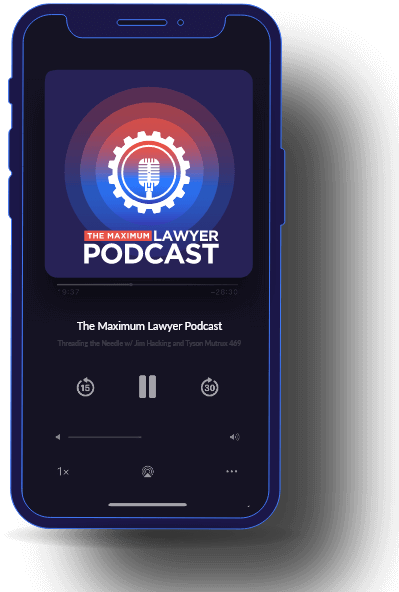Do you struggle with keeping realistic expectations? In this episode of the Maximum Lawyer Podcast, Tyson and Jim share their insights on unbridled optimism and how it relates to the field of law.
This week on the show we have Kelsey Bratcher, owner of Hired Gun Solutions and automation/integration expert second to none. In this episode we’ll discuss the tools you can use to begin automating your firm and compare CRM and Automation technology.
https://www.hiredgunsolutions.com/about/
Hacking’s Hack:
I’ve been really enjoying this podcast called “Momentum” from Alex Charfen. Its about empowering both the entrepreneur and the implementors.
https://www.charfen.com/podcast/
Tyson’s Tip:
Sometimes its ok to hit the reset button and start everything over. It’s better to reset now than later on when you’re deeper into bad habits.
Kelsey’s Tip:
Look at Zapier and Google Docs. Law firm are document oriented and this is where you are going to save the most time and money.
Starting out? Get Pipedrive, Autopilot, and Zapier.
For more content from us please subscribe to our Youtube Channel
Don’t forget to sign up for MaxLawCon20!
Thanks so much for listening to the show! If you want to know more about this and keep on maximizing your firm, please join our Facebook Group or like us on Facebook and comment!
You can also go to MaximumLawyer.com or, if you’d prefer, email us at: [email protected]
Interested in being on the show? Shoot us an email at [email protected] or message us on Facebook!
Guild Membership
Free Access to Stage 1 of Maximum Lawyer in Minimum Time
Sign Up Today!Customer Reviews
4.9 out of 5
Join Our Facebook Group
Enjoy Exclusive Access To Stage One Of The Maximum Lawyer In Minimum Time Course
Privacy Policy
This privacy policy has been compiled to better serve those who are concerned with how their ‘Personally Identifiable Information’ (PII) is being used online. PII, as described in US privacy law and information security, is information that can be used on its own or with other information to identify, contact, or locate a single person, or to identify an individual in context.
Please read our privacy policy carefully to get a clear understanding of how we collect, use, protect or otherwise handle your Personally Identifiable Information in accordance with our website.
What personal information do we collect from the people that visit our blog, website or app?
When ordering or registering on our site, as appropriate, you may be asked to enter your name, email address or other details to help you with your experience.
When do we collect information?
We collect information from you when you register on our site, place an order, subscribe to a newsletter, Use Live Chat, Open a Support Ticket or enter information on our site.
How do we use your information?
We may use the information we collect from you when you register, make a purchase, sign up for our newsletter, respond to a survey or marketing communication, surf the website, or use certain other site features in the following ways:
- To personalize your experience and to allow us to deliver the type of content and product offerings in which you are most interested.
- To improve our website in order to better serve you.
- To allow us to better service you in responding to your customer service requests.
- To quickly process your transactions.
- To send periodic emails regarding your order or other products and services.
- To follow up with them after correspondence (live chat, email or phone inquiries)




